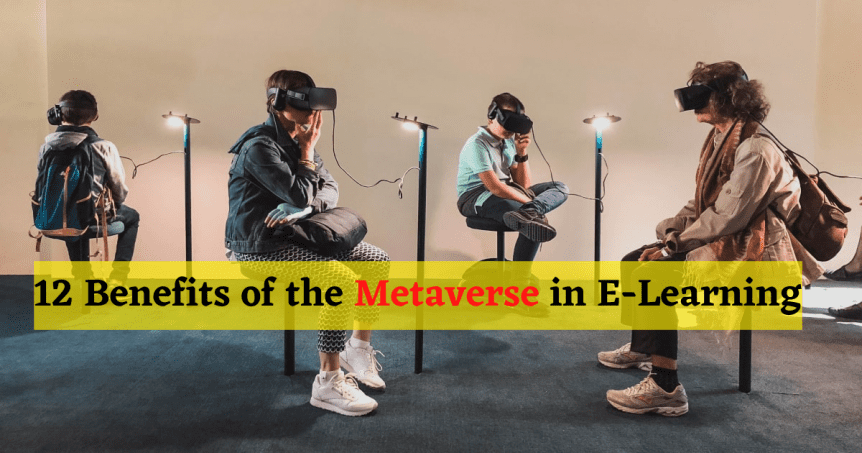12 Benefits of the Metaverse in E-Learning
The metaverse is a term that describes virtual spaces where you interact via an avatar. This includes interacting with the avatars of other metaverse users. Today, the most common application for the metaverse is gaming, but there is growing interest in the potential of this technology for corporate training. So, what are the benefits of the metaverse in e-learning?
Makes Learning a More Interactive and Immersive Experience
When e-learning courses are well-designed, they deliver highly interactive experiences for learners. The metaverse will take the interactivity of e-learning to another level.
We can use navigation as an example. In an e-learning course, navigational elements are typically buttons, where the learner clicks or taps Next or something similar to move to the next screen or the next section of the course.
With e-learning delivered in the metaverse, learners might instead move around a virtual space to engage with the learning content. This is much more interactive than tapping on a Next button.
It will also create a more immersive experience for learners. This applies to any type of e-learning in the metaverse, but it especially applies when the metaverse requires the use of virtual or augmented reality headsets.
Familiar to Learners, Particularly Younger Generations
Many learners in your organisation, particularly younger learners, might already be familiar with metaverse-type experiences. This is because many online games are a type of metaverse. Roblox is a good example.
This familiarity will help learners quickly get up and running with e-learning courses in the metaverse.
Enhances Learner Engagement
Corporate e-learning courses need to do more than create interactive, immersive experiences. E-learning courses also need to educate and develop new skills.
As e-learning in the metaverse is a new concept, there will be enhanced engagement in the initial stages due to the novelty factor. However, with well-designed e-learning courses using metaverse technologies, higher rates of engagement can be an ongoing benefit.
Boosts the Potential of Scenarios
Scenarios are highly effective tools in e-learning courses, as they put learners into real-life simulations where they can apply what they have learned. The metaverse boosts the potential of scenarios as the simulation can move from being a largely text-based description to a visual virtual space.
Almost Anything is Possible
Almost any situation, environment, or place can be created in the metaverse, enabling e-learning content creators to replicate the real-world experience of learners as closely as possible.
Eliminates Risks in Learning
The above point about being able to create any situation or location in the metaverse includes situations and locations that would be highly dangerous in the real world. Creating these situations or locations in the virtual space of the metaverse makes it possible to put learners in challenging and difficult situations without any risk to their personal safety.
While eliminating personal safety risks is beneficial, the metaverse can also be used to provide training to learners in environments that eliminate other risks. Those risks could be reputational or financial risks, for example. In the metaverse, learners can make mistakes without any impact on the organisation.
Suitable for Remote and Hybrid Workers
The metaverse exists online, making it a suitable place to learn for office workers as well as those who work remotely.
Overcomes Video Call Fatigue
Some courses take a blended approach, where part of the course is delivered via e-learning and the rest via instructor-led training. Given the remote, hybrid, and international nature of many modern workforces, the instructor-led elements are often delivered online via video calls.
While video calls offer a range of benefits, there are challenges, including video call fatigue. In a video call, we are aware that our faces are constantly being looked at. Also, it is harder to read non-verbal cues in a video call than it is in an in-person meeting. Both of these factors can make video calls energy-intensive experiences while also causing feelings of stress. This leads to what is known as video call fatigue.
E-learning in the metaverse can overcome this as your interactions are via avatars. For example, during an instructor-led component of an e-learning course, you could attend a virtual classroom as an avatar where you interact with the avatars of the instructor and other learners.
Makes Learning a More Social Experience
E-learning offers a wide range of benefits to corporate training strategies, but one of the few downsides is that it lacks the social aspect of in-person training. Delivering e-learning content in the metaverse can help to bring that social aspect back. The example cited above, of attending a virtual classroom as an avatar, will make the learning experience more sociable.
Better Data for Learning Professionals
Delivering e-learning in the metaverse will give you access to additional data and insights that you can use to enhance courses and improve your training strategy.
Improved Learning Outcomes and Business Results
The overall impact of the benefits highlighted above is that you will achieve better training outcomes from e-learning when it is delivered in the metaverse. This could be everything from enhanced skills, behavioural change, improved knowledge retention, or any other metric that you use to measure training strategy success.
Healthy Return on Investment
Finally, an enhanced learner experience and better training outcomes will ensure you get maximum returns on the investments you make in e-learning using the metaverse.
The Future, Today
The metaverse is widely regarded as a technology of the future. That is true, and much of the take-up of e-learning in the metaverse will be in the future. However, there are technologies that exist today that enable early adopters to take their first steps into the e-learning metaverse. It’s the future, but it exists today.
